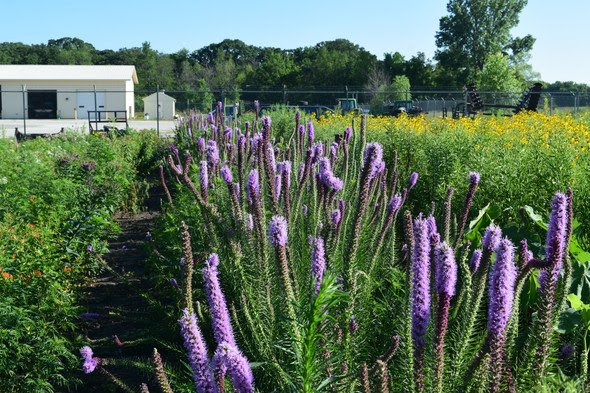Lehigh, Iowa - The prairie around the 6,500-acre Brushy Creek State Recreation Area, in Webster County, is much more than just another pretty flower – it’s the source for prairie seeds planted on Iowa state parks and wildlife areas.

Photo: Rows of species-specific plots growing 2,000 prairie plants per plot sit outside the greenhouse at the Prairie Resource Center, at Brushy Creek State Recreation Area. The plants started in the adjacent greenhouse then planted as plugs, hand weeded and seeds hand-harvest. It’s the most labor-intensive method to collect seed at the center.
At one time, nearly 80 percent of Iowa was covered in prairie. The Iowa Department of Natural Resources (DNR) Prairie Resource Center cultivates and harvests native plant seed to establish new prairies on public land. Bill Johnson, wildlife biologist for the Iowa DNR, is responsible for overseeing seed production and filling orders for the increasing demand for prairie seed since the facility opened in 2000.
The initial seed to begin growing prairies here was collected from remnant native prairies on the state preserves.
“We want the best prairie on our public land and that’s what we’re trying to promote here,” Johnson said. “I want everyone to see the to see the benefits provided by prairies that I see.”
The Prairie Resource Center and surrounding fields have grown more than 100 different prairie plant species, but not every year. Johnson uses a combination of species-specific cultivated plots growing 2,000 plants per plot, blocks of land planted with little bluestem then 20-foot-wide strips of specific prairie plants, and whole fields with established prairies to provide seed requested by land managers.
“The individual plots are the most labor intensive,” he said. “We plant plugs started in our greenhouse, hand weed the plots and hand harvest the seeds. We can combine the field strips later, which is less labor intensive, but that method doesn’t work on all species. For example, we tried planting prairie blazing star in strips but rodents ate the bulbs underground.”
For species that work using the field strip method, Johnson said they can harvest about 50 pounds of seed per year. This year, golden Alexander and partridge pea is doing really well. White indigo too, but white indigo will probably be harvested by hand.
Harvest begins in May for the early seeds, but the bulk occurs from the middle of August to middle of October. For plants that mature late, frost is key to finalizing the seed harvest.
All seed collected here is used on public land, mostly state parks and wildlife areas, and does not go to private landowners. Johnson does work with private landowners looking for advice on seed mix and on how to establish a prairie.
“Planting a prairie takes time and the transition doesn’t happen overnight,” he said. “We prepare the area by cropping it for one or two years to eliminate any brome or canary grass that may be present.”
First year prairies are weedy and require mowing to keep the annual weeds down, allowing the prairie plants to put down roots, get moisture and sunlight. “Getting the plants off to a good start that first year is key,” Johnson said.
Once the prairie is established, the native plants can out compete unwanted invasive species. Prairies attract bugs and provide habitat important for grassland birds and pheasants and the flowers are important for pollinators. The stems and root systems benefit water quality by standing up in heavy rain, slowing runoff and keeping soil in place.
“It’s habitat for all – pheasants, quail, turkeys, butterflies and bees,” he said.
Johnson said Iowa State University visited the reconstructed prairie managed by the center searching for the federally endangered rusty-patched bumble bee and the American bumble and found both in one day.
“This shows that habitat is the key, if you plant it, wildlife will soon follow,” he said.
This is a statewide program supported by the sales of hunting and fishing licenses. No federal funds are used to support it. Information on the Prairie Resource Center is available online at https://www.iowadnr.gov/conservation/prairie-resource-center
Expanding knowledge of the prairie
The Prairie Resource Unit has hosted government agencies, school groups, scholars, even foreign scientists – and has hosted the North American Prairie Conference.
“We’ve worked with different public entities – county road departments, conservation boards - to help us to produce seed, maybe one or two species, and in exchange they get a share of our seed mix in return for growing that one species,” Johnson said.
He said they’re partnering with Polk, Lee, Boone, Winneshiek and Franklin County conservation boards, and will add Story County next year. And he’s looking for more.
“We’ve been doing this for 22 years, usually with species that we’ve had good luck growing and have a recipe for success,” he said. “What I want is a diverse prairie everywhere on our public lands.”
He’s regularly hosted groups of master gardeners and master conservationists, staff with the Natural Resources Conservation Service, and since 2006, has held a service learning program in the spring with Webster County sixth graders and the county naturalist who help with plantings and cutting brush while learning about the prairie.
Russian grassland biologists along with their translator were touring the United States, and visited the Prairie Resource Unit around the fall of 2012. They toured the single species plots and saw a demonstration of combining and harvesting seeds. While most spoke some English, as long as Johnson could say the plant name in Latin, they understood.